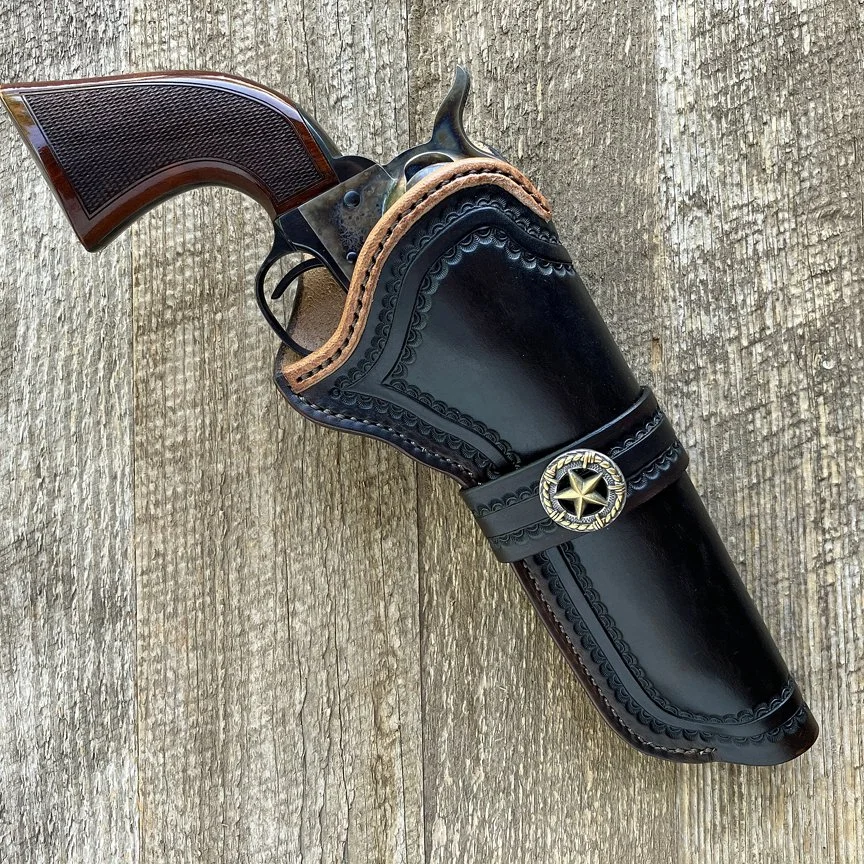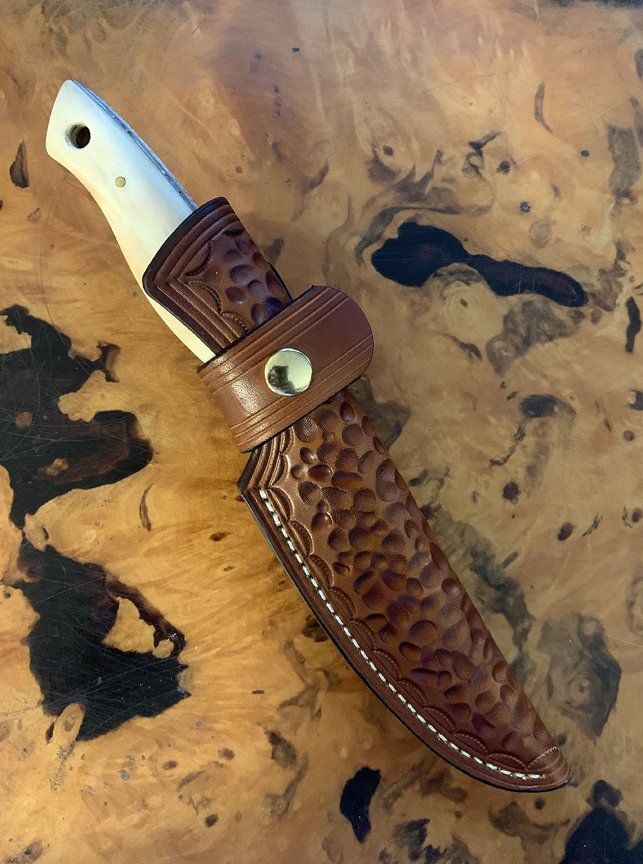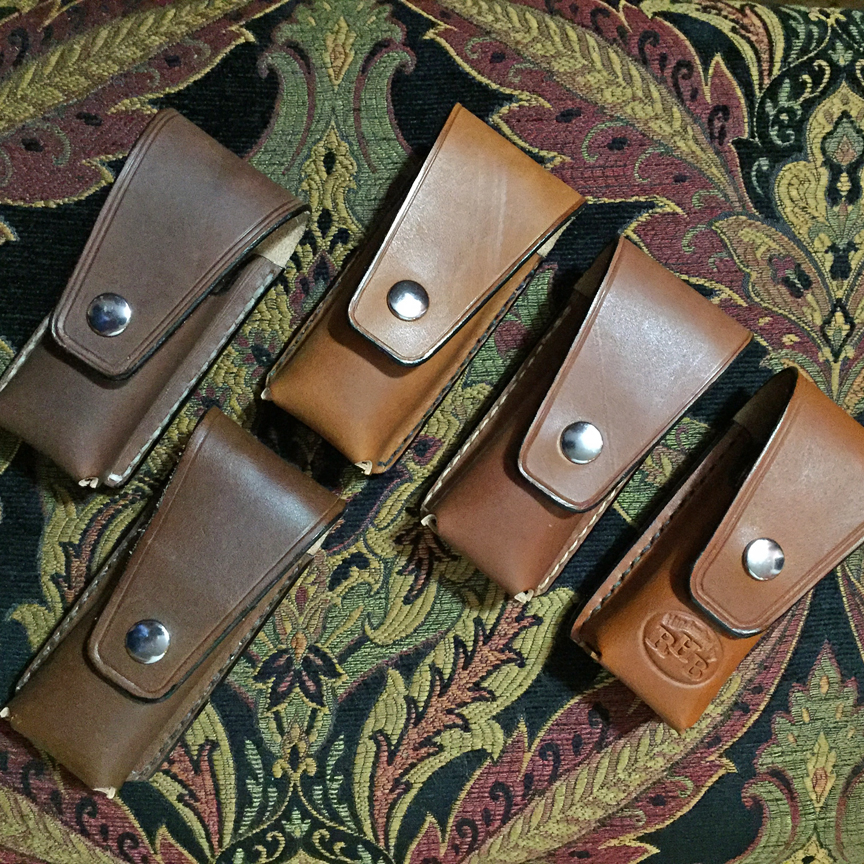Holster Gallery
Welcome to The Gun Carriage. This site was set up to display some of the holsters I have made and fitted handgun cases I have built, and to offer you an opportunity to contact me if you would like to discuss how I might make one or the other for your favorite gun. The photos and text below offer an opportunity to explain in a little more detail what I was attempting on any given work, where the design may have come from, how it's put together, and how it might be modified to be more personal. I recently figured out how to navigate the new (to me) editing process on the website, so, if you’ve been here before, you may see some new work. I have been busy lately, so there may be additional “new” pieces appearing more or less regularly.
Most of the projects you'll see were developmental in nature, so I will be as likely to comment on what didn't work as on what did. I have been making custom holsters for seven years now. If you notice the same grips sticking out of more than one example in the gallery, it’s because most of the holsters I’ve done for clients have been without the benefit of the gun, and most of the client photos I’ve received have been inconsistent in lighting, background, and overall quality, so I didn’t feel I could use them in a gallery. So, what you see here is mostly made on spec and made to fit guns to which I have access. For most of my “for hire” work I’ve had to rely on a stock photo and dimensions. These seem to have been successful, based on the remarks of the purchasers, and so I'm developing a growing library of patterns for various models. But I prefer to work with the actual gun or a quality mold, and my library of molds is growing, but by no means exhaustive. I am fond of Army and Navy Colt replicas, 1873 Single Action Army revolvers, and 1911's, no matter who actually makes them, and I'm developing an affinity for medium frame 4" .38 specials. I’ve made holsters for guns ranging from the Kimber micro to the 10.5 inch Ruger Super Blackhawk, with a scope. Most have been somewhere in between those extremes.
All of the examples below are hand stitched, laced, stained, dyed, oiled, stamped, carved, or left as nature intended. Pricing, when or if presented, will be general for the time being, because I expect all projects to be custom, and will be happy to discuss once I understand what the client wants. I now include a slightly wider range of products, as my recent projects have included a number of portfolios, binder covers, cartridge holders, and scabbards for items like multi-tools. Magazine holders and rifle slings will likely show up soon, as well.
Following your initial contact, we can discuss your needs or interests and arrive at a mutually satisfactory price on any projects we may undertake. If you don't see anything of interest on this visit, I invite you to come back another time; the photos in the Gallery will be updated periodically as new projects are completed. There is a "Contact" menu option at the top of the page. For the time being, that is the best, and only way, to reach me. I have added a space for customer testimonials and comments, though it has not been updated in some time.
So, for the time being, I’ll have to ask for your patience and invite you to return from time to time. I’ve been pretty busy making stuff, and I’ve been neglecting this site for too long. Hope to remedy that in the weeks or months ahead. Thanks for stopping by, and I hope to see you again soon.
I’ve mentioned elsewhere on the site that I’m fond of the 1911. Here’s a recent piece for the 5” government model with the tiny GI battle sights. The holster body is Show Brown, with a black border and black hand stitching. It is lined with pigskin and features black throat binding, a Mexican loop with a rather bold concho, and a toe plug. It’s a perfect fit for the small front sights, but a little grippy on 1911 variants with taller sights. In my view, this is one of the more graceful holsters I’ve had the pleasure to make. Regarding the throat binding, as nice as it looks, I am finding that it works better on revolvers than on semi-auto pistols, as the front ledge of the ejection port can catch even the thinnest binding. I’ve not seen any issues with revolvers.
I recently had occasion to make several variations on this pattern for the Colt New Frontier 4 3/8” model with target sights. I had to work from photos, so this was the first attempt. It easily fits the Ruger Wrangler and Single Six with traditional sights and the Heritage Rough Rider. For the “final” piece I cut down the throat a little for the rear sight, shortened the toe slightly for the barrel length, and opened the toe a tiny bit for the larger front sight. This holster is shown with a Ruger Wrangler. The color is an antiqued Spanish brown fade. It features an oiled leather binding strip at the throat, dark brown pigskin lining, a faux Mexican loop, and a concho that complements the diamond stamping.
I was asked recently to make a proper holster for a Ruger Old Army .44 cap and ball revolver. I went to my pattern library and found one claiming to be the right one. I probably should have been suspicious when it also claimed to fit the 1860 army Colt. The Ruger is massive, has a top strap, and just feels huge. Unsurprisingly, it was too big for the pattern. I revised accordingly and wound up with a nice home for the Ruger. The holster shown here is the one I made with that first pattern. It’s a modified open-toe El Dorado, lined with pigskin, tooled with a basketweave, and sporting an enormous 1881 silver dollar concho on the loop strap to contrast the USMC black dye. I’ve included a hammer loop on this holster but no leg ties.
This project was made for the 3.7” Hellcat Pro. I worked from photos, and have yet to test the fit on a real live Hellcat, so I display it here with a M&P Shield EZ, the profile of which is a close match. The color is an antiqued fade application of an accidental brown mixture that I developed by blending five years of experimental mixes in one container. In that regard, I consider it to be unique, though it is pretty close to Spanish brown. It is stamped with a dragon scale stamp and lined with dark brown pigskin.
One of the things I like about the full-size 1911 is how well it adapts to a variety of styles and patterns. This one features floral carving with a modified Mexican loop securing the holster to a skirt, which serves as the belt loop. Though more common with 19th century revolvers, the style works on the trusty 1911 as well. I’ve used a russet dye on this one, with natural stitching for contrast. The toe is closed.
I had been wanting to try this tooling technique for some time as it lends itself to either a western or a more contemporary style. This is fitted to a Heritage 6.5" .22 single action revolver, in fact, the same one used as a stand-in in the nearby photo of the Ruger Single Six holster. The discerning will note that this holster is for a southpaw, and features the typical western leg ties and hammer loop. I used a brown stain and a tan thread for a little contrast. Stitching is by hand.
I’ve been doing a little research and have found inspiration in a wonderful book by Richard Rattenbury. This rig is based on a Mexican Loop style prevalent in the late 19th century and fits the 1873 single action army Colt. The buckle is nickel plated with clipped corners and the lining is pig skin with the suede side out. The belt is a little over 2.5” wide with two keepers, one for the belt and one for the billet. The buckle and billet ends are stitched and riveted. Holster and belt are dyed dark brown
I recently had an opportunity to build a holster for a Glock 17. I’d developed this pattern a few months back, but sold the holster before I got a photo. This one is a mahogany basket stamp with natural stitching, a dark brown lining, and a snap strap. It is canted slightly forward, and the toe is open. This pattern is one that I like for the G17/47, and it appears in another example nearby with different tooling.
I've been meaning to do a revolver holster with cartridge loops for some time and the opportunity finally arrived with this one, built for a 6.5" .22 LR revolver. The loop strap provided a platform for the .22 cal. loops, with no room to spare. The throat binding is black pigskin, and the stitching is black to match the leather. I used a border stamp on the holster, a slightly smaller version of the same stamp on the loop strap, and a teeny version of the same stamp on the bullet loops themselves.
When I first started working with leather, I wanted to try out a pattern for the 1860 army Colt. In my opinion, the army and navy Colts are among the most graceful handguns ever made. The confederate model is in Spanish brown and the federal model is USMC black. The insignia were hand-carved, rather than embossed. In that regard, and others, this pair doesn’t hold up to the specs of serious re-enactors, but they’re handsome holsters for one of my favorite guns.
Finally figured out a reasonable way to photograph a cartridge belt in a square format. This is a complete rig for the 4.75” SAA. Cartridge belt has twenty loops and is lined with thin pigskin. Holster has appeared alone in the past and the color of the belt is not a perfect match. Still have not put a hammer loop on this holster, but the leg tie is present.
I had been itching to do an inlay of some sort and when I found a small stingray hide I took it as a sign. I use a pattern that I’ve used before and found quite versatile. I finished it with USMC black dye and lined it with black pigskin, and though I think it’s aesthetically pleasing, I did not enjoy working with the stingray skin. Seems that nature endowed the stingray with a hide armored with small glass beads. It’s an interesting texture, but hard on the tools.
My wife thinks this is a "dress" holster, as in, Sunday-go-to-meetin'. While I doubt that guns were common in 19th century church services, I agree that it has a formal and classic look to it, and it would go well with a brown suit. It features a folded skirt and a functional buckled strap. The tooling is minimal, only a scribed outline. The color is a medium brown stain. I like this holster for its simplicity and for its proportions. I used a snap to secure the strap, though a leather or metal keeper would be simpler and just as effective.
This was commissioned some time ago and I only recently thought to add it to the gallery. The gun is a 3.5” derringer and the customer wanted a safety strap and easy access to a couple of extra rounds. The color is either dark brown or Spanish brown, with an antique finish. The stamping is a random stipple that I’ve used a few times to provide texture without a pattern. The holster is canted slightly forward and the hammer is fully shielded by leather.
As I've stated elsewhere in this site, the thing I like most about the 5” 1911 is that it allows for a variety of graceful holster patterns. This is one of my favorites, and I’ve used it several times with different details, colors, textures, and ornamentation. This piece is an inlay of faux alligator embossed leather, installed in a border of stained veg-tan cowhide. I used a medium application of Briar Brown stain to complement the dark brown inlay, and contrasted it with buff-colored stitching. The holster is lined with veg-tan cowhide to give it a little more heft and stiffness, which I’ve enhanced further with a couple of additional layers of leather stitched into the main seam.
From an old pattern for the Ruger Single Six, in this case the 6.5" model. Ample room for contemporary front and rear sights. The gun in the photo is a Heritage 6.5" revolver and it sits a little loose. Holster features a floral carving and complementary stitching. Finished version could/would have a leg-tie and hammer loop. No edging or stamping, antique stain in a medium brown. Belt loop is a stitched fold-over. This one has an open toe. Sufficient room to close the toe without changing the pattern. Very similar to 1851 carved holster shown nearby, but without skirt.
For this holster I added a little more girth to accommodate a fully configured revolver, shortened the depth very slightly, and added a little length to the belt loop so it would hang a little lower. The gun sits a little lower in the holster, and fits it well, without a wet-fit. The holster is stamped with a favorite basket weave and stained mahogany. I dyed the inside to minimize contrast between the outside and the inside. Final finish was a satin top coat.
Here’s the more refined version of the three-piece Mk III holster displayed elsewhere in the gallery. In all particulars except for coloring and finish, this piece is identical to its more rustic brother. I suppose one is for work and the other is for going out in polite company. Though I’m not yet sure about the Mk IV, this pattern fits the earlier Mk I and Mk II Rugers, and is very easily adapted to the longer and heavier-barreled Target models.
This holster fits the 5.5" SAA revolver and employs a double Mexican loop to secure the skirt, which serves as the belt loop. I've applied a dark brown dye and used dark brown stitching to keep it low key. The diamond stamping provides a texture that contrasts with the smooth loops.
Some holsters are just made to be functional, and strangely enough, they are sometimes the most fun to make. This holster uses a pattern that I’ve worked with a couple of times for the P226, but it features minimal tooling, no ornamentation, no lining, and minimal finish work. I made it from a scrap of Herman Oak, and added a safety strap left over from another job that used saddle skirting. The finish is three or four heavy applications of walnut oil. I sanded the main seam, and burnished that, and the other edges, a little, with a piece of canvas, like they did in the old days. The overall finish is rustic and rugged.
Here’s another full-size 1911, made from a pattern in an old Tandy holster pattern book. It’s really more of a bucket, but it’s a clean design, and it works well with a barrel-heavy pistol like the 1911. This one is a briar brown stain/antique applied to a dragon scale stamp. The stitching is “natural” (off white), about five per inch. I’ve lined it with maple pig skin. The original pattern included a toe plug, and so have I. With soft lining I’ve noticed that a low, rounded front sight, like the original 1911 battle sight, works better. Taller sights with a sharp profile can dig into the lining a little and impede the draw.
I’ve displayed a few holsters for the shorter-barrel version of the SAA, but only recently had occasion to make a home for the 5.5” inch version. This one features a dark (really dark) brown stain with minimal tooling, a modified Mexican loop, my favorite star and “bob-wahr” concho, a small toe plug, and a narrow binding at the top of the throat.
Here's another variation on a familiar pattern. This holster is a dark Spanish brown fade with a medium brown antique finish over a diamond stamp, with contrasting natural stitching. The throat binding is a light pigskin. I've used a wider loop strap than in a similar, earlier piece, and installed a complementary oval concho.
I went to a gun show a week ago and learned that there are far more left-handers in the general population than I had imagined. I now have a list of projects that will be made for southpaws. This SAA is among the first of them. I used a simple pattern with a Mexican loop, maple pig skin lining, and folded the lining over the throat and stitched it down. I added a stitched border to the Mexican loop. The color is a heavy application of medium brown dye, with natural thread for contrast.





































































